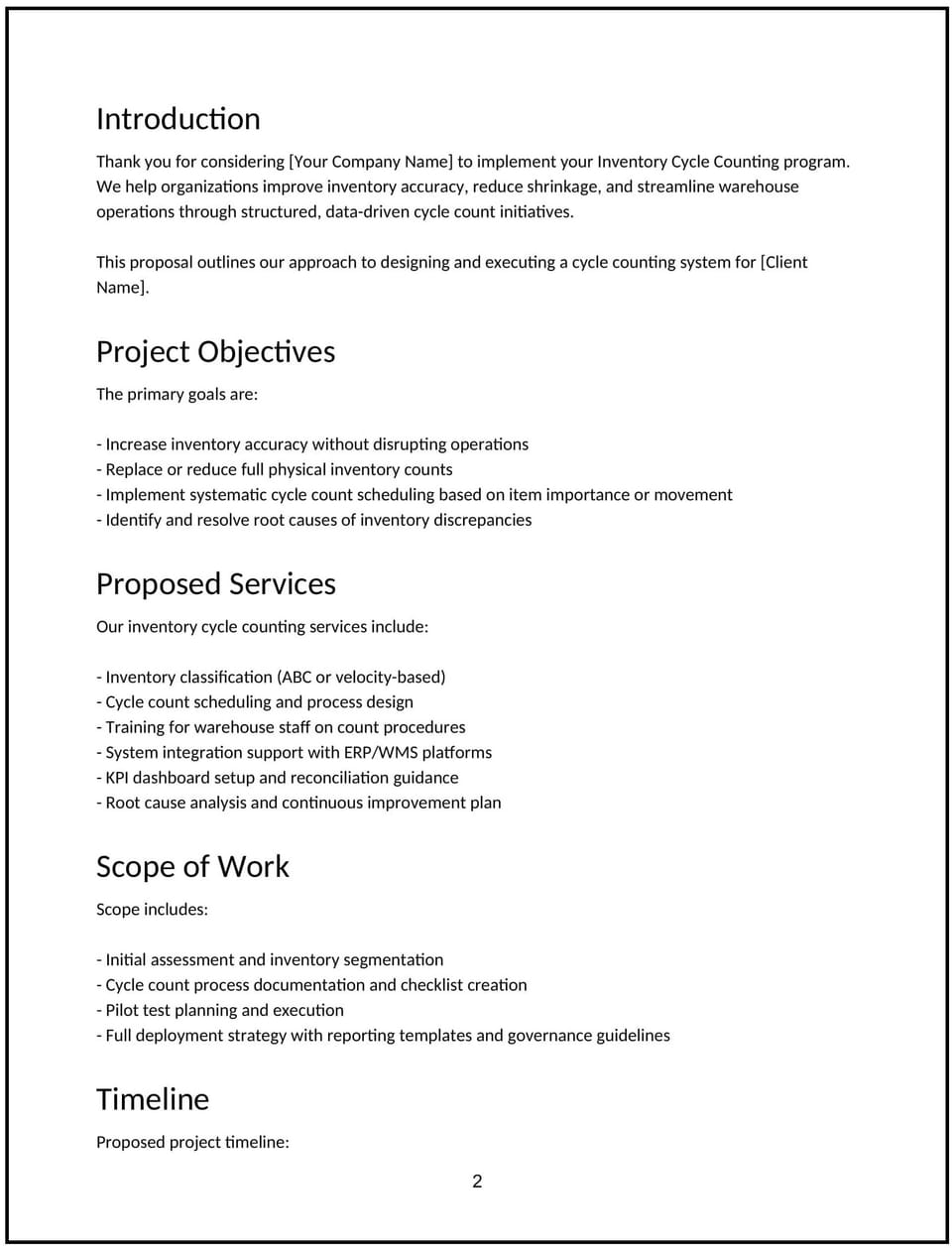Inventory cycle counting proposal: Free template

Customize this free inventory cycle counting proposal with Cobrief
Open this free inventory cycle counting proposal in Cobrief and start editing it instantly using AI. You can adjust the tone, structure, and content based on your client’s inventory size, systems, and frequency needs. You can also use AI to review your draft — flag gaps, clarify scope, and improve accuracy before sending.
Once you're done, send, download, or save the proposal in one click — no formatting or setup required.
This template is fully customizable and built for real-world use — ideal for warehouses, manufacturers, distributors, and retail operations looking to improve inventory accuracy without full physical counts. Whether you're offering a one-time audit or ongoing cycle count program setup, this proposal helps you define the process and demonstrate value.
What is an inventory cycle counting proposal?
An inventory cycle counting proposal outlines how you’ll help a business improve inventory accuracy through routine cycle counts — breaking the stockroom into manageable sections and verifying inventory records on a recurring basis. It includes the scope of items reviewed, process design, system updates, and reporting.
This proposal is typically used by inventory consultants, warehouse managers, or operations advisors working with clients that need better inventory control, reduced shrinkage, or compliance with audit requirements.
Unlike a full inventory count, this focuses on a continuous, less disruptive approach that integrates into daily operations.
Why use Cobrief to edit your proposal
- Edit the full proposal instantly: No spreadsheet uploads or formatting delays — open and customize in-browser.
- Use AI to tailor your scope: Adjust based on count frequency, stock type, and inventory software.
- Run a full AI-powered review: Catch vague counting processes, missed audit steps, or unclear deliverables.
- Apply edits in one click: Accept all suggestions or review by section.
- Save, send, or download: Export your finalized proposal as a clean, professional PDF.
When to use this proposal
- When helping a business improve inventory accuracy through structured cycle counts
- When offering cycle counting as part of a broader warehouse optimization or ERP implementation
- When replacing annual full physical counts with a less disruptive alternative
- When supporting compliance, audit readiness, or inventory valuation improvement
- When advising on operational best practices in logistics or retail
What to include in an inventory cycle counting proposal
- Project overview: Describe the goal — such as improving inventory accuracy, reducing shrinkage, or ensuring system alignment with physical counts. Tailor this to the client’s operations and frequency needs.
- Scope of work: List what’s included — such as ABC classification, scheduling, count procedures, variance analysis, root cause reporting, and inventory system updates. Clarify if you’re designing the program or executing the counts.
- Timeline: Provide a project timeline — from planning and staff training to pilot cycles and full implementation. Include key milestones like first variance review or reporting cadence setup.
- Deliverables: Specify what the client will receive — such as a cycle count schedule, training materials, reporting templates, a variance tracker, and optional dashboard integration.
- Pricing: Outline your pricing — fixed fee for setup, per-location audits, or hourly execution. Note whether ongoing monitoring or corrective action tracking is included.
- Call to action / next steps: Close with a clear prompt — approve the proposal, confirm count frequency, or schedule a kickoff meeting. Keep it easy to act on.
How to write an effective inventory cycle counting proposal
- Emphasize efficiency: Show how cycle counts improve accuracy without major disruption.
- Tailor to stock types: Identify if the client handles perishables, high-value SKUs, or serialized items.
- Show financial value: Reference cost savings through reduced write-offs, improved cash flow, or audit performance.
- Align with systems: Mention how counts will sync with ERP or WMS software.
- Keep it process-driven: Provide structure and clarity around how the counts will be scheduled and managed.
- Close with confidence: End with a CTA that reinforces action and preparedness.
Frequently asked questions (FAQs)
What is the difference between cycle counting and a full physical count?
Cycle counting is a continuous process that counts portions of inventory on a rotating basis, reducing disruption. A full count typically shuts down operations and happens annually.
How often should cycle counts be performed?
Frequency depends on item value and movement — A-items may be counted monthly, B-items quarterly, and C-items annually. You can define the schedule in the proposal.
Can this proposal be used for multi-location operations?
Yes — just clarify which sites are included and whether procedures are standardized across them.
Does the proposal include inventory system integration?
It can. You can offer system configuration or reporting automation depending on the client’s tools (e.g., NetSuite, SAP, Zoho Inventory).
Is this a legally binding agreement?
No — this proposal outlines your scope and pricing. A separate contract or statement of work should follow upon approval.
This article contains general legal information and does not contain legal advice. Cobrief is not a law firm or a substitute for an attorney or law firm. The law is complex and changes often. For legal advice, please ask a lawyer.